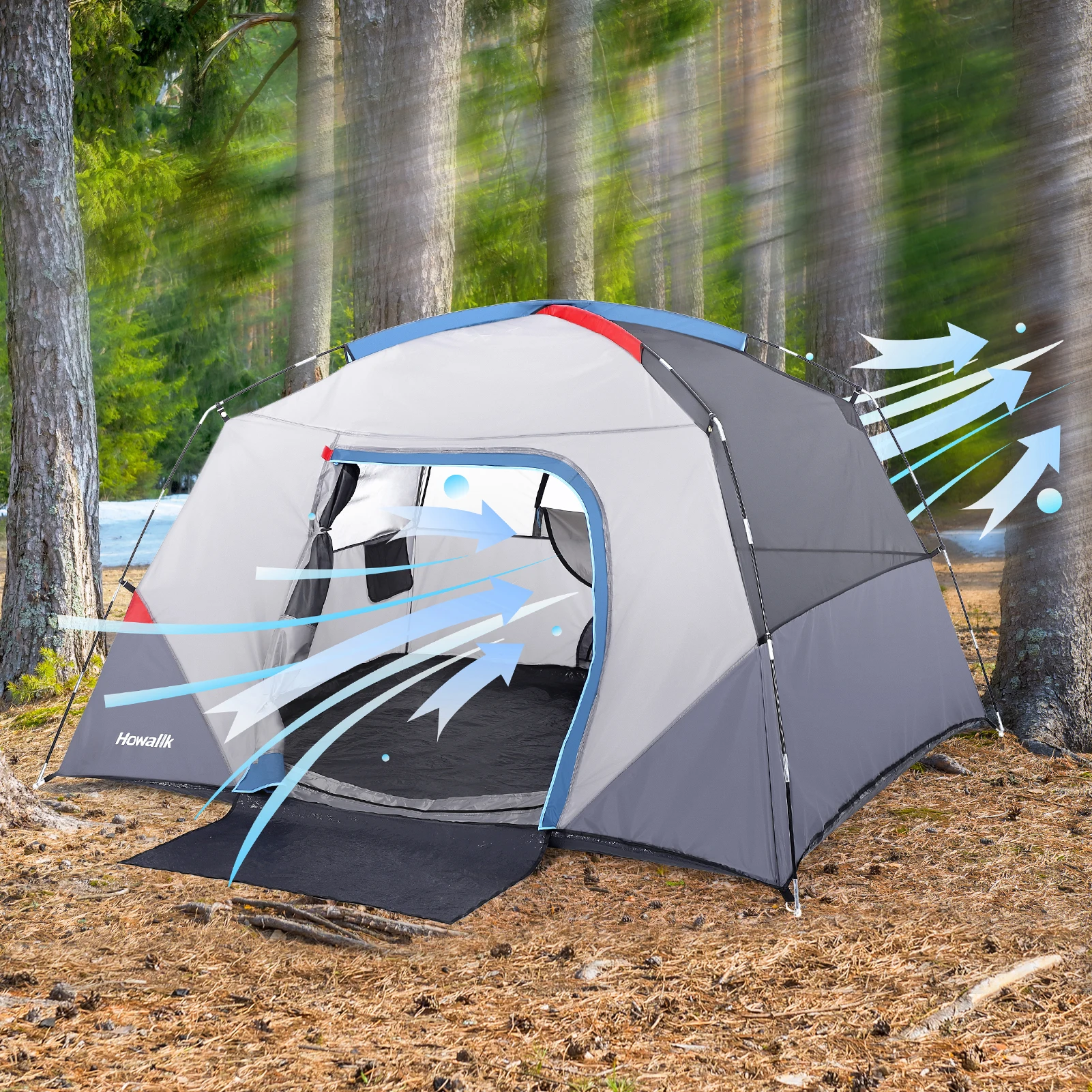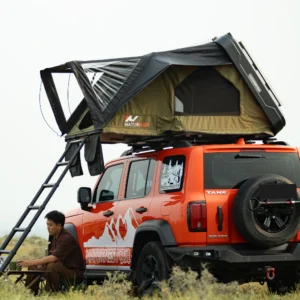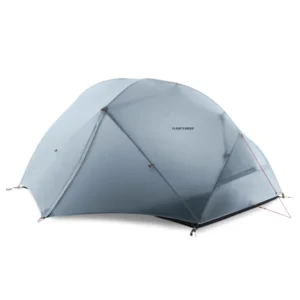Introduction: The Critical Role of Weather Resistance in Your Shelter
When you venture into the wilderness, your tent becomes your lifeline against the elements. Wind and snow load capacity aren’t just technical specifications on a product label—they’re crucial factors that determine whether your shelter will stand strong or collapse when nature unleashes its fury.
Understanding these technical ratings is essential when selecting a tent for harsh environments. A tent failure in extreme conditions can quickly transform an adventure into a survival situation. Exposure to severe weather without adequate protection can lead to hypothermia, frostbite, and other dangerous scenarios that experienced outdoor enthusiasts work diligently to avoid.
Wind can tear stakes from the ground, snap poles, and rip fabric. Heavy snow can collapse even seemingly sturdy structures under its weight. According to outdoor safety organizations, gear failure accounts for a significant percentage of wilderness emergencies during extreme weather events.
In this guide, we’ll explore what wind and snow load ratings actually mean, examine the design features that enhance weather resistance, provide criteria for evaluating tent performance, and share practical setup techniques to maximize your shelter’s stability. For those heading into challenging conditions, investing in quality gear isn’t a luxury—it’s a necessity for safety and comfort.
When planning expeditions into harsh environments, selecting durable tents for all seasons becomes a critical decision that can significantly impact your outdoor experience.
Decoding Wind Load Capacity in Tents
Wind doesn’t just blow against your tent—it creates complex forces that test every aspect of your shelter’s design. Understanding these forces helps explain why some tents remain standing while others fail when conditions deteriorate.
How Wind Impacts Tent Structures
Wind affects tents through three primary forces:
- Pressure: Direct force pushing against the windward side
- Lift: Upward suction effect created when wind passes over the tent
- Drag: Horizontal pulling force on the lee side
The relationship between wind speed and force is not linear—it’s exponential. When wind speed doubles, the force it exerts quadruples. This explains why a seemingly modest increase from 30 mph to 60 mph winds doesn’t just double the stress on your tent—it increases it by four times.
Measuring Wind Load Capacity
Wind load capacity is typically expressed in:
– Miles per hour (MPH)
– Kilometers per hour (km/h)
– Beaufort scale ratings
For example, a quality backpacking tent might be rated to withstand 30-45 mph winds, while expedition tents designed for extreme conditions may handle gusts of 60-80+ mph.
Testing Methods and Standards
Manufacturers determine wind ratings through several methods:
– Wind tunnel testing: Controlled laboratory conditions
– Field testing: Real-world environments with measurable conditions
– Structural analysis: Engineering calculations based on materials and design
Unlike structural buildings, consumer tents lack a standardized industry testing protocol, which can make comparing specifications between brands challenging. Some manufacturers provide conservative ratings based on extensive testing, while others may offer more optimistic figures based on ideal conditions.
For specialized environments like high-altitude mountaineering, understanding wind resistance in alpine tents becomes particularly important as conditions can change rapidly at higher elevations.
Key Factors That Determine Wind Resistance in Tent Design
The ability of a tent to withstand powerful winds depends on several interconnected design elements working together as a system.
Aerodynamic Design
The tent’s overall shape dramatically affects its wind performance:
- Dome tents: Offer good all-around wind resistance with their rounded profile
- Geodesic tents: Provide superior stability with multiple pole crossings
- Tunnel tents: Can be very stable when oriented correctly with the narrow end facing the wind
- A-frame tents: Generally less stable in high winds due to flat surfaces
- Pyramid tents: Can shed wind effectively but may require more careful setup
Low-profile designs minimize wind resistance by presenting less surface area to gusts. The height-to-width ratio is a critical factor—taller tents catch more wind, while wider, lower designs typically remain more stable.
Pole System Strength
The framework that supports your tent is often the first point of failure in extreme conditions:
- Aluminum alloys: Offer excellent strength-to-weight ratio with various grades (7000-series being among the strongest)
- Carbon fiber: Provides exceptional strength and lightweight properties but can be brittle
- Fiberglass: Common in budget tents but generally insufficient for extreme conditions
Pole diameter, wall thickness, and sectional design all contribute to overall strength. Multiple pole intersections create triangulated structures that distribute stress more effectively than simple designs.
Fabric Properties
The tent’s skin plays a crucial role in wind resistance:
- Ripstop nylon: Features reinforced threads that prevent tears from spreading
- Polyester: Often more resistant to UV degradation and stretching when wet
- Dyneema/Cuben fiber: Ultra-lightweight with exceptional strength but at premium cost
Higher denier ratings (the thickness of individual fibers) generally indicate stronger fabrics, though weave pattern and treatment also matter significantly. Smaller fabric panels distribute stress more effectively than large expanses of material.
For long-term performance in challenging environments, understanding the most durable tent material options helps you make informed choices when selecting gear for extreme conditions.
When durability in high winds is a primary concern, exploring options among heavy-duty 4-season tents can provide the robust protection needed for challenging adventures.
Understanding Snow Load Capacity in Tents
Snow accumulation creates a silent but potentially destructive force on your tent structure. Unlike wind—which announces its presence with noise and movement—snow builds up gradually, adding substantial weight that can collapse your shelter while you sleep.
The Weight of Winter
Snow load capacity refers to how much accumulated snow weight a tent can support before structural failure occurs. This capacity is typically measured in pounds per square foot (or kilograms per square meter), though consumer tent manufacturers rarely provide specific ratings.
The density and moisture content of snow dramatically affect its weight:
- Wet, heavy snow: Can weigh 20+ pounds per cubic foot
- Light, powdery snow: May weigh as little as 7 pounds per cubic foot
For perspective, just 4 inches of heavy, wet snow on a standard 2-person tent can add over 100 pounds of pressure to the structure—equivalent to a person standing on your tent roof.
Measuring and Understanding Snow Load
Unlike wind ratings, specific snow load capacity figures are uncommon in consumer tent specifications. Instead, manufacturers typically categorize tents as “3-season” (minimal snow handling) or “4-season/winter” (designed for snow loads).
The relationship between snow load capacity and overall structural strength is direct—tents with stronger pole systems and more robust fabrics generally handle heavier snow accumulation. However, design elements like roof angle also significantly impact snow-shedding capability.
For winter camping enthusiasts, understanding the four-season tent features and benefits provides essential knowledge about structures designed specifically to handle significant snow loads.
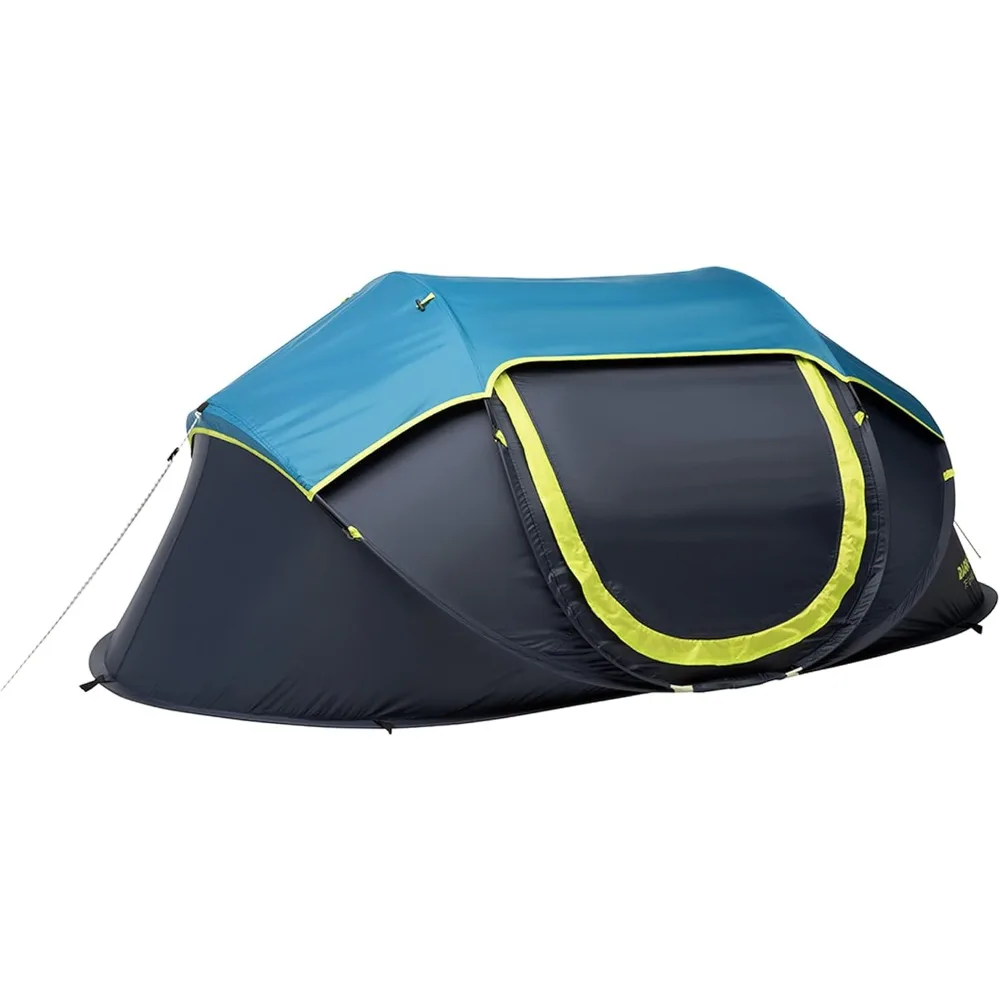
Design Features That Enhance Snow Resistance
Effective snow-resistant tents incorporate specific architectural elements that work together to prevent snow accumulation and support substantial weight.
Roof Architecture
The design of a tent’s upper surface significantly impacts its snow-handling capabilities:
- Steep angles: Promote natural snow shedding through gravity
- Rounded designs: Prevent snow from building up in flat pockets
- Panel configuration: Smaller panels with strategic seam placement distribute stress more effectively
The most effective snow-shedding designs balance headroom needs with steep enough angles (typically 40+ degrees) to encourage snow to slide off rather than accumulate.
Structural Reinforcements
Effective snow-resistant tents feature:
- Reinforced pole configurations: Often with additional crossing points for load distribution
- Strategic cross-bracing: Provides extra support at critical weight-bearing locations
- Enhanced pole-to-fabric connection points: With reinforced webbing and multiple attachment methods
The ideal pole system for heavy snow conditions creates a geodesic or semi-geodesic structure with multiple intersection points, distributing weight across the entire framework rather than concentrating it in vulnerable areas.
Snow Management Techniques
Beyond design considerations, practical snow management includes:
- Regularly brushing accumulated snow from tent surfaces
- Monitoring drift patterns and clearing potential buildup areas
- Choosing fabrics with slick outer finishes that discourage snow adhesion
When camping in snowy environments, knowing how to properly set up your shelter makes a significant difference. For practical field techniques, mastering chill: guide to winter snow tents provides valuable information for maintaining a safe, comfortable shelter.
For those specifically seeking equipment designed for snowy conditions, winter camping tents offer specialized features that enhance performance when snow loads are anticipated.
Essential Materials and Components of Weather-Resistant Tents
The difference between standard camping equipment and true weather-resistant shelters often comes down to the quality and design of their core components.
Pole Systems
Premium pole materials significantly impact a tent’s ability to withstand extreme forces:
| Pole Material | Strength Characteristics | Weight Ratio | Cold Weather Performance |
|---|---|---|---|
| DAC Aluminum | Very high tensile strength | Moderate | Excellent |
| Carbon Fiber | Exceptional strength | Ultra-light | Good but can become brittle |
| Aerospace Aluminum | Superior strength | Moderate to heavy | Excellent |
The connection between poles and fabric also matters significantly:
- Sleeve systems: Provide continuous support but can be difficult to assemble in harsh conditions
- Clip systems: Offer easier setup and better ventilation but potentially fewer attachment points
- Hybrid systems: Combine sleeves at critical stress points with clips elsewhere
Tent Fabric Technology
Weather-resistant tent fabrics balance multiple competing priorities:
- Ripstop nylon: Exceptional tear strength with relatively light weight
- Polyester: Better UV resistance and dimensional stability when wet
- High-denier materials: Thicker threads (70D+) provide greater puncture and abrasion resistance
Waterproof coatings add another dimension to fabric performance:
– Silicone impregnation: Offers superior durability and water resistance
– Polyurethane coatings: More affordable with good initial water resistance
– Multiple layer applications: Higher hydrostatic head ratings (10,000mm+) for extreme conditions
Reinforcement Elements
Critical reinforcement features include:
- Bar-tacked stress points: Additional stitching at guy-out points and pole insertions
- Bathtub floor construction: Wrapped floor material extends up sides for superior water resistance
- Seam sealing technology: Factory-taped or sealed seams prevent water penetration
- Quality hardware: Metal components instead of plastic at critical connection points
Ventilation Systems
Effective weather-resistant tents must balance weatherproofing with condensation management:
- Adjustable roof vents: Allow hot air and moisture to escape while preventing precipitation entry
- Protected side vents: Provide airflow even during inclement weather
- Vestibule design: Creates transition zones that buffer interior spaces
Understanding all-season tent materials guide helps you recognize quality construction when evaluating options for challenging environments.
For compact options that don’t compromise on material quality, 4-season winter 2-person tents combine robust construction with reasonable packability.
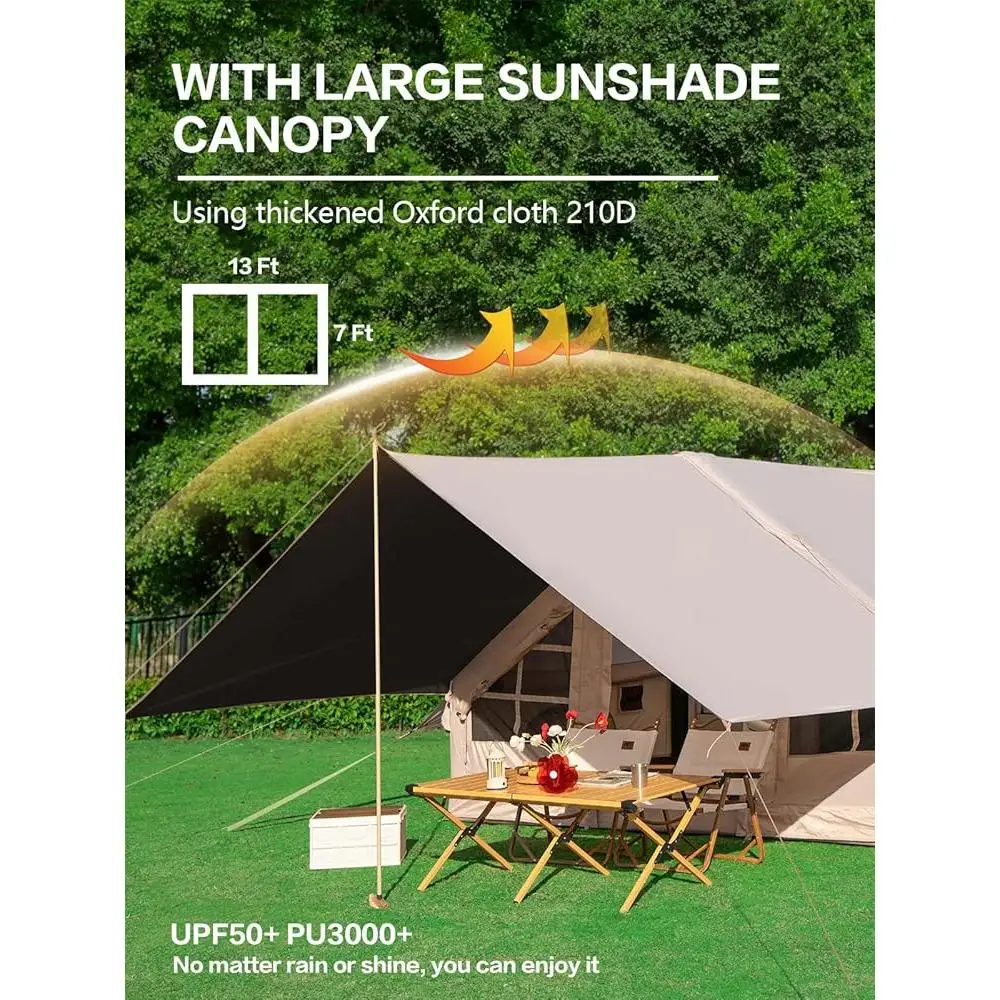
Tent Classifications for Extreme Conditions
Different tent categories offer varying levels of protection against environmental stresses. Understanding these classifications helps match your shelter to expected conditions.
3-Season Tents
These general-purpose shelters are designed for spring through fall camping in moderate conditions:
- Wind capacity: Typically rated for winds up to 20-30 mph
- Snow handling: Minimal to none; not designed for snow accumulation
- Advantages: Lighter weight, better ventilation, typically lower cost
- Limitations: Insufficient for winter storms, high winds, or snow loads
3-season tents prioritize weight savings and ventilation over structural strength, making them unsuitable for genuinely harsh conditions.
4-Season (All-Season) Tents
Despite the name, these tents are primarily optimized for winter use:
- Wind capacity: Generally engineered for sustained winds of 30-50 mph
- Snow handling: Designed to support moderate snow loads
- Advantages: Versatile for year-round use, substantial protection in moderate winter conditions
- Limitations: Heavier than 3-season models, may be overly warm in summer
True 4-season tents feature stronger poles, more robust fabrics, and designs that shed snow while withstanding significant wind pressure.
Expedition/Mountaineering Tents
These specialized shelters represent the pinnacle of weather resistance:
- Wind capacity: Engineered for extreme winds exceeding 50-80+ mph
- Snow handling: Substantial capacity for heavy snow loads
- Advantages: Maximum protection in the harshest environments
- Limitations: Heaviest weight, largest packed size, highest cost
Expedition tents incorporate multiple poles, reinforced attachment points, and ultra-durable materials throughout. They’re designed to withstand prolonged exposure to extreme conditions at high altitude or in polar regions.
For extended outdoor adventures in challenging environments, four-season tents built for durability provide the protection needed when weather conditions become severe.
Those heading into alpine environments should consider mountaineering tents specifically engineered to withstand the unique combination of high winds, heavy snow, and extreme temperature fluctuations found at higher elevations.
How to Evaluate Tents for Wind and Snow Performance
With countless models on the market making various weather-resistance claims, knowing how to assess actual performance capabilities becomes essential for making informed purchases.
Interpreting Manufacturer Specifications
Look beyond marketing claims to find substantiated information:
- Specific wind ratings: Numerical ratings (in MPH/km/h) with testing methodology explained
- Pole material details: Specific aluminum alloys (7000-series) rather than just “aluminum”
- Denier specifications: Exact denier ratings for fly, floor, and body fabrics
- Testing evidence: References to specific testing protocols or third-party verification
Red flags in specifications include vague terms like “storm-proof” or “expedition quality” without supporting technical details, or unusually high performance claims from budget-priced products.
Critical Design Elements to Assess
When evaluating tent designs, prioritize:
- Pole configuration: More crossing points generally mean better structural integrity
- Guy-out systems: Look for multiple reinforced attachment points with reflective cording
- Fabric weight and construction: Higher denier ratings at stress points and floor
- Vestibule design: Adequate size and configuration for gear storage and weather buffering
- Seam construction: Taped and reinforced at critical junctures
Balancing Considerations
The ideal tent balances multiple factors according to your needs:
- Weight vs. strength: Additional structural support inevitably adds weight
- Packability vs. stability: More poles mean better stability but larger packed size
- Ventilation vs. weather protection: Adequate airflow without compromising storm resistance
- Cost vs. performance: Price often (though not always) correlates with performance in extreme conditions
Value of Expert Input
Beyond manufacturer claims, seek:
- Reviews from extreme environment users: Feedback from mountaineers, winter campers, and expedition leaders
- Independent testing: Reports from outdoor organizations and publications
- Actual field performance: Real-world experiences in conditions similar to those you anticipate
For additional criteria when evaluating potential purchases, understanding weather resistance and durability in camping tents provides valuable perspective on features that contribute to long-term performance.
Strategic Site Selection and Setup for Maximum Stability
Even the most robust tent will fail if improperly positioned or inadequately secured. Strategic site selection and proper setup dramatically improve your shelter’s performance in extreme conditions.
Choosing the Optimal Location
When positioning your tent in challenging environments:
- Identify natural windbreaks: Use terrain features like boulders, dense trees, or snow banks to buffer wind—while staying safe from falling hazards
- Assess anchoring options: Look for ground that will securely hold stakes or allow for alternative anchoring methods
- Avoid hazardous zones: Stay clear of avalanche paths, drainage channels, and areas with deadfall risk
- Consider snow drift patterns: Anticipate how wind will deposit snow around your shelter
Orientation Strategies
Proper tent orientation can significantly impact stability:
- Position the lowest, most aerodynamic end of the tent facing the prevailing wind
- Align tunnel tents with their length parallel to wind direction
- Set up dome tents with doors perpendicular to wind direction when possible
- Adjust orientation based on terrain features that might channel or amplify wind
Preparation Techniques
Before pitching your tent in snow:
- Compact the snow thoroughly by stamping it down with skis, snowshoes, or boots
- Create a level platform slightly larger than your tent’s footprint
- Consider digging a shallow pit for the vestibule area to provide additional protection
- Pack snow around the tent base after setup to prevent drafts and secure the edges
Understanding how snow tents differ from regular shelters helps in recognizing the special considerations needed when camping in winter conditions.
Advanced Anchoring Techniques for Extreme Conditions
Standard tent stakes often prove inadequate in winter conditions or during severe storms. Advanced anchoring techniques provide crucial additional security.
Snow-Specific Anchoring Systems
When camping on snow, use specialized anchoring methods:
- Deadman anchors: Bury stuffsacks, branches, or dedicated snow anchors horizontally in compacted snow, with the guy line attached to the middle
- Snow stakes and flukes: Use specialized wide-profile stakes designed to maximize surface area contact with snow
- T-slot snow anchors: Create T-shaped trenches where the horizontal section resists upward pull
For each snow anchor, compress the snow thoroughly after placement and allow it to harden for at least 30 minutes before applying full tension.
Frozen Ground Solutions
When the ground is too frozen for standard stakes:
- Use specialized stakes with serrated edges designed to cut into frozen soil
- Consider using rocks to secure guy lines when stakes won’t penetrate
- Look for natural anchoring points like exposed tree roots or stable rocks
- Use “dead blow” techniques with a rock to drive in sturdy stakes without damaging them
Optimizing Guy Line Systems
To maximize your tent’s stability:
- Tension all guy lines evenly to distribute stress
- Use adjustable tensioners to manage line tension as conditions change
- Set up redundant anchoring for critical attachment points
- Position guy lines at approximately 45-degree angles for optimal resistance
- Check and adjust tension periodically, especially after temperature changes or precipitation
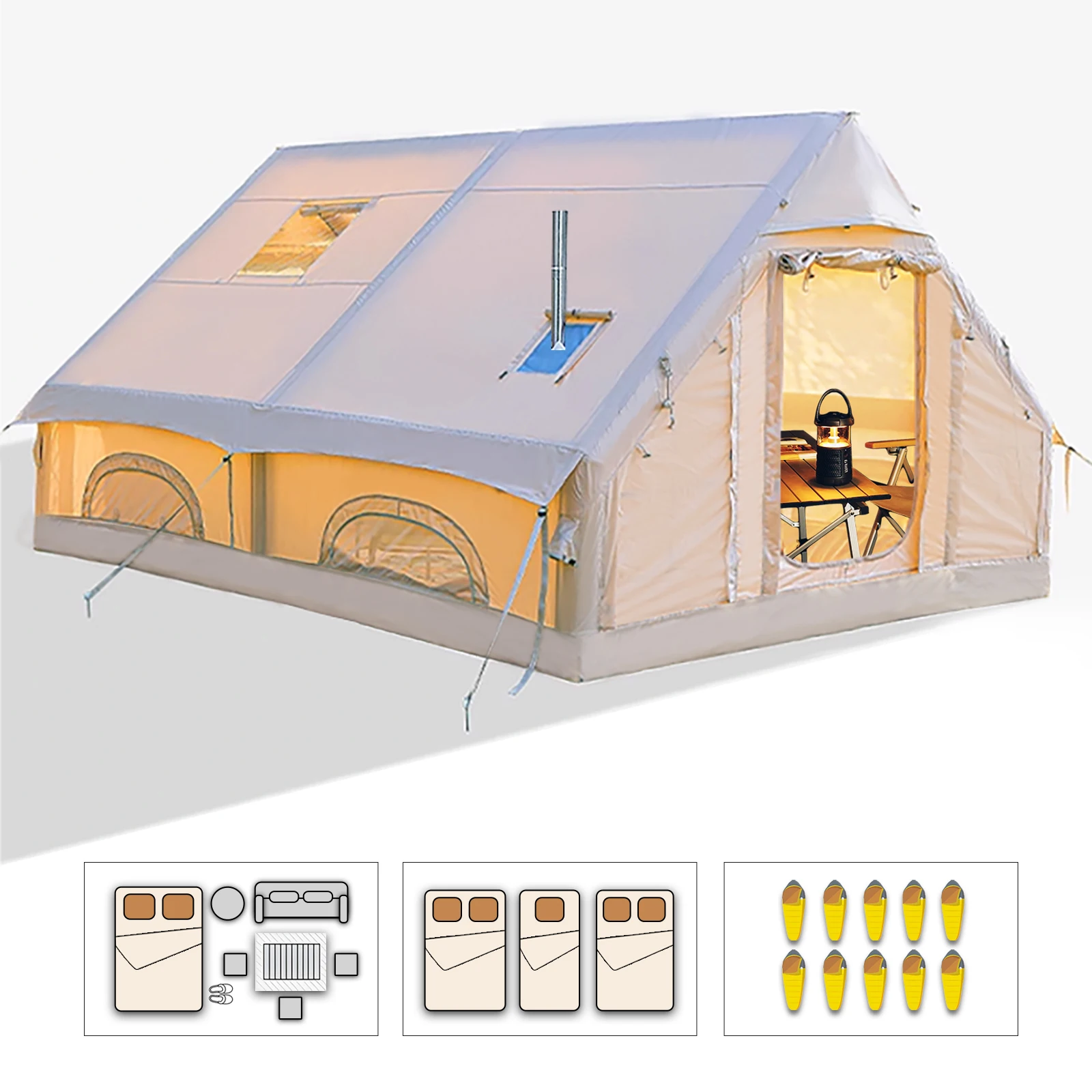
For specific techniques to enhance stability in challenging conditions, mastering wind stability in freestanding tents offers valuable insights for maintaining shelter integrity when winds intensify.
Heavy Duty 4 Season Tent, Mountaineering Tent, Winter Camping Tent
$870.40 Select options This product has multiple variants. The options may be chosen on the product pageUltralight Backpacking Tent, Ultralight Dome Tent, Winter Camping Tent
Price range: $369.63 through $370.07 Select options This product has multiple variants. The options may be chosen on the product pageHeavy Duty 4 Season Tent, Ultralight Freestanding Tent, Winter Camping Tent
$3,722.66 Select options This product has multiple variants. The options may be chosen on the product pageHeavy Duty 4 Season Tent, Winter Camping Tent
$638.69 Select options This product has multiple variants. The options may be chosen on the product pageHeavy Duty 4 Season Tent, Winter Camping Tent
$5,109.59 Select options This product has multiple variants. The options may be chosen on the product pageBackpacking Tent with Vestibule, Heavy Duty 4 Season Tent, Trekking Pole Backpacking Tent, Winter Camping Tent
Price range: $257.52 through $537.51 Select options This product has multiple variants. The options may be chosen on the product page
Conclusion: Selecting and Using Weather-Resistant Tents
When facing nature’s most challenging conditions, your tent becomes your most critical survival tool. Selecting the right shelter requires understanding the technical aspects of wind and snow resistance while also recognizing how design features translate to real-world performance.
The most important considerations when selecting a weather-resistant tent include matching its capabilities to your expected conditions, understanding the tradeoffs between weight and strength, and recognizing that proper setup dramatically affects performance. Remember that even the most robustly engineered tent requires proper site selection, orientation, and anchoring to perform at its best.
Your safety in extreme environments depends on making informed choices about your gear and knowing how to use it effectively. By understanding the principles behind wind and snow load capacity, you can select equipment that provides reliable protection when you need it most.
For those planning ambitious expeditions, exploring durable tents for extreme outdoor adventures provides additional insights into shelters designed specifically for the most challenging environmental conditions.

